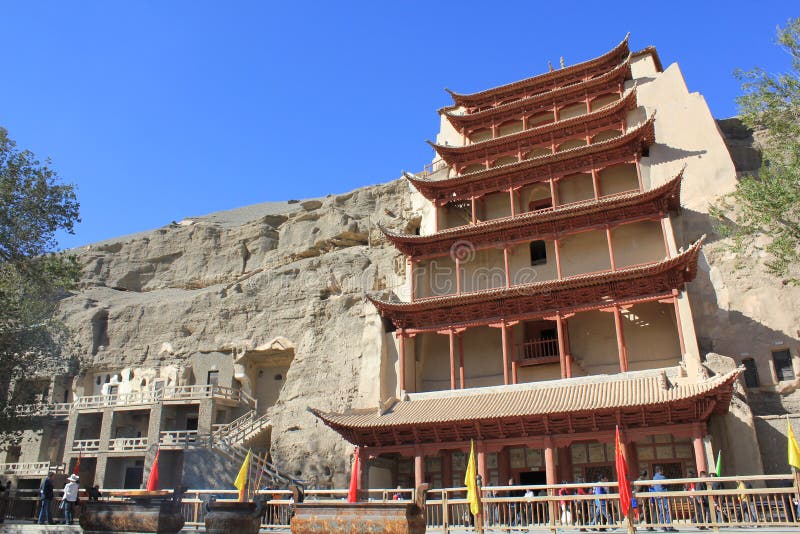This photo is taken in Dunhuang, China, The Mogao Caves Chinese: 莫é«Ë窟; pinyin: MògÃÂo kÃ
«; Wadeââ¬âGiles: Mo4-kao1 k`u1, also known as the Thousand Buddha Grottoes Chinese: Ã¥ÂÆä½âºÃ¦Â´Å¾; pinyin: qiÃÂn fó dòng, form a system of 492 temples 25 km 16 mi southeast of the center of Dunhuang, an oasis strategically located at a religious and cultural crossroads on the Silk Road, in Gansu province, China. The caves may also be known as the Dunhuang Caves, however, this term is also used as a collective term to include other Buddhist cave sites in and around the Dunhuang area, the Western Thousand Buddha Caves, Eastern Thousand Buddha Caves, Yulin Caves, and Five Temple Caves. The caves contain some of the finest examples of Buddhist art spanning a period of 1,000 years.[1] The first caves were dug out in 366 AD as places of Buddhist meditation and worship.[1][2] The Mogao Caves are the best known of the Chinese Buddhist grottoes and, along with Longmen Grottoes and Yungang Grottoes, are one of the three famous ancient Buddhist sculptural sites of China.
圖片編號:
97734934
拍攝者:
Nhungbuocchan
點數下載
| 授權類型 | 尺寸 | 像素 | 格式 | 點數 | |
|---|---|---|---|---|---|
| 標準授權 | XS | 315 x 480 | JPG | 13 | |
| 標準授權 | S | 525 x 800 | JPG | 15 | |
| 標準授權 | M | 1403 x 2137 | JPG | 18 | |
| 標準授權 | L | 1812 x 2759 | JPG | 20 | |
| 標準授權 | XL | 2292 x 3490 | JPG | 22 | |
| 標準授權 | MAX | 3520 x 5360 | JPG | 23 | |
| 標準授權 | TIFF | 4978 x 7580 | TIF | 39 | |
| 進階授權 | WEL | 3520 x 5360 | JPG | 88 | |
| 進階授權 | PEL | 3520 x 5360 | JPG | 88 | |
| 進階授權 | UEL | 3520 x 5360 | JPG | 88 |
XS
S
M
L
XL
MAX
TIFF
WEL
PEL
UEL
| 標準授權 | 315 x 480 px | JPG | 13 點 |
| 標準授權 | 525 x 800 px | JPG | 15 點 |
| 標準授權 | 1403 x 2137 px | JPG | 18 點 |
| 標準授權 | 1812 x 2759 px | JPG | 20 點 |
| 標準授權 | 2292 x 3490 px | JPG | 22 點 |
| 標準授權 | 3520 x 5360 px | JPG | 23 點 |
| 標準授權 | 4978 x 7580 px | TIF | 39 點 |
| 進階授權 | 3520 x 5360 px | JPG | 88 點 |
| 進階授權 | 3520 x 5360 px | JPG | 88 點 |
| 進階授權 | 3520 x 5360 px | JPG | 88 點 |



























 +886-2-8978-1616
+886-2-8978-1616 +886-2-2078-5115
+886-2-2078-5115






